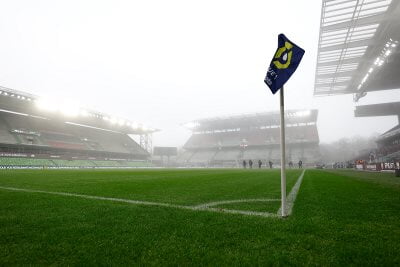The Vélodrome, the Parc des Princes, the MATMUT Atlantique, the Stade Pierre-Mauroy, the Allianz riviera… As we enter the heart of winter, find out about the different strategies planned to protect Ligue 1 Uber Eats pitches around France.
It's the same problem every winter for Uber Eats' Ligue 1 stadium groundsmen: how to deal with falling temperatures? Cold weather, increased precipitation and the appearance of snow lead to a period that is always complicated for pitch management. Holding meetings becomes a complex equation. To overcome these difficulties and help clubs during the winter period, the LFP has established a number of measures over the years to improve its pitch protection system. Here is an overview of the main initiatives.
If we look at the archives, the LFP experimented with and approved the use of tarpaulins to cover pitches as early as December 2003, before offering financial support to clubs wishing to equip themselves. The LFP also provided two tarpaulin systems for clubs to use in the event of extreme conditions at a non-equipped stadium. The aim of these investments, apart from protecting the pitches from the weather, was to maximise the chances of keeping matches on their original schedule.
Investments by the clubs
Following these initial measures, clubs have over time equipped themselves with ever better technology to withstand their local climates. After adopting the use of tarpaulins in all stadiums, they have notably equipped themselves with hot air blowers to cope with periods of extreme cold. In addition, over the last ten years, massive investments in thermal regulation systems under the pitch surfaces have also been made, making it possible to limit the formation of frost deep in the substrate, and therefore the risk of unplayable pitches.
In June 2013, a Météo-France subscription was also taken out to enable clubs to follow the weather forecasts on site before matches, both at home and away. Knowing that forecasts are available ten days in advance, becoming increasingly reliable as kick-off approaches, French league clubs can monitor trends on a daily basis and adapt their strategy to deal with any developing problematic conditions.
This awareness and investment on the part of the clubs is linked to the inclusion in the LFP regulations of elements concerning the obligation to respect the conduct of matches, and therefore the protection of the pitches. In the event of non-compliance with these directives, the club at fault may be financially sanctioned.
Field delegates
In addition to requiring clubs to have a pitch supervisor, the LFP has also set up a network of pitch delegates, each of whom is responsible for monitoring weather conditions at a stadium in his or her geographical area in order to prevent any risks. If necessary, the pitch delegate must alert the LFP, which, depending on discussions with the club and the reading of the forecasts, may decide to send a representative to the site to check the actual state of the playing surface. This system is activated from November to March in order to alert all stakeholders.
Currently, the Match Operations Department, in addition to all these elements, ensures a last-minute watch, using its knowledge of the equipment in each stadium. This support is provided with the aim of further limiting any risks. Monitoring on Friday therefore makes it possible to target the match that could be problematic at the start of the weekend. In the event of a postponement, priority is always given to the following day, conditions permitting, so as not to disrupt the sporting schedule of the teams concerned, with a possible additional match to be played during the week.
>> User's manual: Pitch protection





